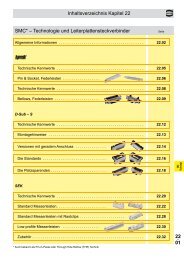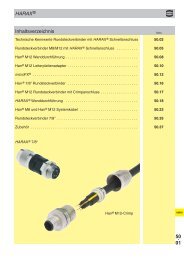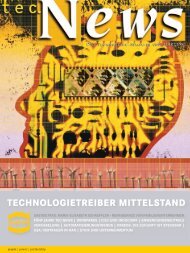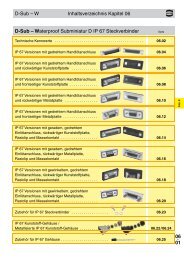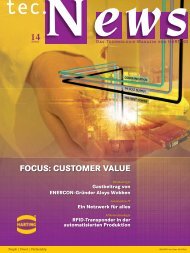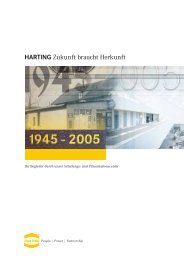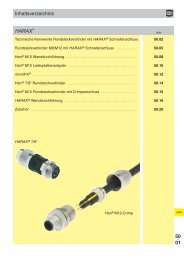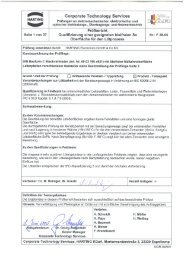tec.News - Harting
tec.News - Harting
tec.News - Harting
Create successful ePaper yourself
Turn your PDF publications into a flip-book with our unique Google optimized e-Paper software.
<strong>tec</strong>.<br />
S p e c i a l t o p i c<br />
APPLICATIONS<br />
CompactPCI unites computer and telephone<br />
Gerd Weking<br />
T<br />
he year 2000 will soon be upon us and with it the much-acclaimed<br />
knowledge and information society. The sheer quantity of information<br />
is growing continuously; available any time, any place, it increasingly<br />
permeates both our work and our private life. Numerous<br />
intelligent telecommunications services are already a reality, for<br />
example guidance of telephone callers by synthetically generated<br />
voices and automatic routing to the relevant call centre.<br />
It will not be long before other visions<br />
also become reality. The in-<br />
Standards designed to ensure that<br />
CONVERGENCE OF MARKETS<br />
telligent mobile phone sends your the computer and telecommunications<br />
worlds grow together are<br />
choice of evening meal to your<br />
home, where the intelligent refrigerator<br />
checks its contents and<br />
puter telephony (CT). In addition,<br />
summarised under the term, com-<br />
automatically orders any missing<br />
CT is a synonym for new multimedia<br />
information <strong>tec</strong>hnologies, with<br />
food items via the Internet. Mobile<br />
communication and the Internet<br />
which transmission of speech, video<br />
signals and data can be com-<br />
are bringing forth new services.<br />
The growth in networking of intelligent<br />
communications equipment learning, and another is telephone<br />
bined. An example of this is tele-<br />
is also bringing together two sectors<br />
of industry which used to be<br />
both of which also illustrate how<br />
conversation via the Internet –<br />
clearly delineated – computers<br />
CT can produce cost savings. Even<br />
and telecommunications.<br />
today, CT is already a sector of<br />
industry that is growing at a tremendous<br />
pace. New and better<br />
systems are appearing with evergreater<br />
regularity. At the same<br />
time, the compatibility problems<br />
familiar from current telephone<br />
systems are to be avoided from<br />
the outset by intensive standardisation<br />
efforts.<br />
STANDARDISATION OF<br />
SOFTWARE AND HARDWARE<br />
An important element in computer-based<br />
(Fig. Siemens)<br />
telecommunications<br />
equipment is the integration of<br />
a so-called telecom bus. When CT<br />
development began, bus systems<br />
developed in-house dominated,<br />
but before long the first steps towards<br />
standardisation were being<br />
taken. Since 1996, 140 manufacturers<br />
and telephone companies<br />
have joined together in the VoIP<br />
(Voice over Internet Protocol)<br />
Forum in order that the same<br />
level of reliable world-wide accessibility<br />
is achieved with Internetsupported<br />
voice data transmission<br />
as with conventional telephone<br />
networks.<br />
(Fig. Intel)<br />
Similarly, in the USA there is the<br />
ECT Forum (Enterprise Computer<br />
Telephony Forum), a grouping of<br />
leading industry representatives<br />
with the task of agreeing open<br />
standards for equipment inter-<br />
29<br />
People Power Partnership



